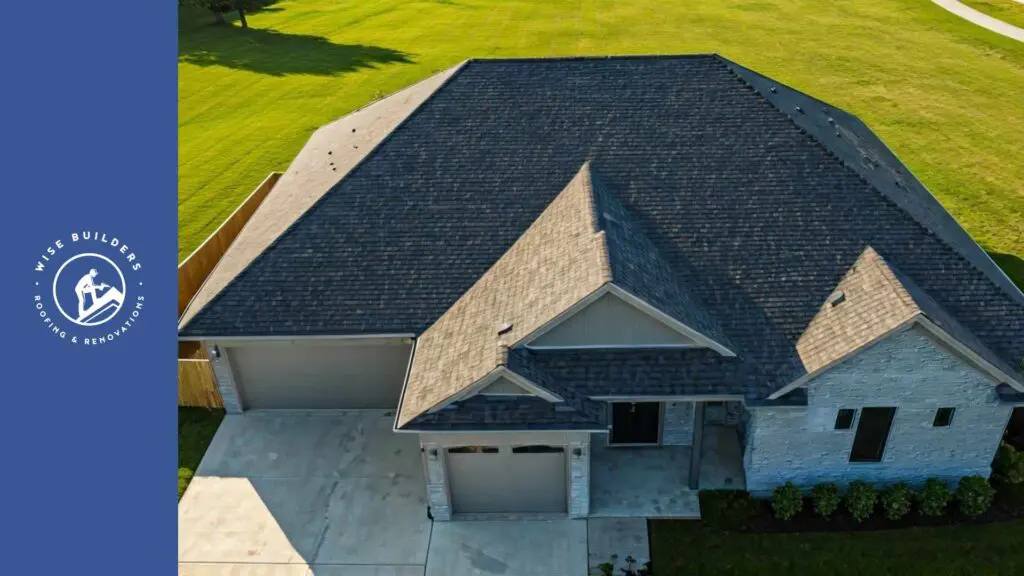
Key Highlights
- Roofing material costs vary widely, with asphalt shingles being the most affordable and slate being the most expensive.
- Factors like roof size, slope, and design complexity significantly influence the overall cost of materials.
- Labor costs for installation can vary based on the roofing contractor’s experience, location, and the intricacy of the project.
- High-end roofing materials like slate and metal offer longevity, durability, and enhanced aesthetic appeal, potentially increasing property value.
- Strategic planning, including timing purchases, exploring financing options, and choosing the right contractor, helps manage roofing expenses effectively.
Introduction
Embarking on a roof replacement project for your home involves numerous considerations, with one of the most critical being the cost. While factors like labor and disposing of old roofing materials contribute to the overall cost, the roofing material itself often constitutes the largest expense. Understanding the factors influencing roofing material costs is crucial for making informed decisions that align with both your budget and desired outcomes for your new roof.
Understanding Roofing Material Costs

When it comes to roofing materials, the market offers a wide array of choices, each with its own price tag. The cost of roofing materials is influenced by several factors, including their type, durability, material quality, and even regional availability.
For instance, asphalt shingles are generally more budget-friendly than metal roofing or slate, which are known for their longevity and premium aesthetic.
Overview of Popular Roofing Materials
Asphalt shingles remain a popular choice for homeowners due to their affordability and ease of installation. Metal roofing, on the other hand, offers exceptional durability and longevity, often lasting several decades with minimal maintenance.
Clay tiles, favored for their timeless elegance and energy efficiency, provide a durable and fire-resistant option, particularly suitable for hot climates.
For those seeking a natural and rustic appearance, wood shingles and shakes, crafted from cedar, redwood, or pine, offer another premium roofing material option. However, wood roofs require more maintenance and are susceptible to moisture damage in humid climates.
Cost Analysis by Roofing Material Types
When budgeting for your new roof, it’s essential to compare the cost of different roofing materials and understand the overall replacement cost. This comparative analysis provides a general overview of price points:
| Roofing Material | Price per square foot |
|---|---|
| Asphalt Shingles | $1 – $4 |
| Metal Roofing | $5 – $14 |
| Clay Tiles | $7 – $18 |
| Wood Shingles/Shakes | $5 – $18 |
| Slate Roofing | $10 – $30 |
While asphalt shingles present a cost-effective option, premium materials like slate come with a higher price tag but offer exceptional longevity and aesthetic appeal.
Factors Influencing the Cost of Roofing Materials

The fluctuating nature of the roofing industry means material costs are not set in stone. Market trends, supply and demand, and even seasonal variations can cause price fluctuations.
Furthermore, the complexity of your roof design, such as steep pitches or intricate details, can influence the cost by demanding more specialized materials or installation techniques.
Availability and Market Trends
Just like any other industry, the roofing industry is subject to market fluctuations. The cost of raw materials, manufacturing processes, and even transportation expenses can impact the final price of roofing materials.
For example, during peak seasons or after severe weather events that lead to increased demand, material prices may surge due to limited supply.
Staying informed about current market trends and consulting with your roofing contractor for insights can help you make informed decisions, especially if you have flexibility in your project timeline.
Labor Costs and Installation Complexity
While the price of roofing materials plays a substantial role, it’s important not to overlook the cost of labor and installation requirements. Installing a roof is a skilled trade, and labor costs can vary significantly depending on the complexity of your roof design and the contractor’s experience.
Steep pitches, intricate roof lines, or the need for specialized installation techniques will generally command higher labor rates.
Therefore, when obtaining estimates, discuss the project scope thoroughly with potential roofing contractors to ensure a clear understanding of labor costs.
The Role of Roof Size and Design in Cost

Intuitively, the size of your roof plays a significant role in determining the overall cost. A larger roof requires more materials, which naturally translates to higher expenses.
However, the complexity of your roof design also plays a crucial role. Intricate designs with numerous slopes, valleys, or dormers often demand more time, specialized materials, and skilled labor, ultimately impacting the project cost.
How Roof Size Impacts Material Needs
Roofing materials are typically measured and sold in “roofing squares,,” with one square covering 100 square feet. To determine your roof’s size in roofing squares,, you’ll need to measure its length and width, factor in the slope, and include any dormers, overhangs, or other protrusions.
The total square footage of your roof will dictate the amount of material needed, directly impacting the cost. For accurate measurements, consider consulting a professional roofing contractor who can provide a comprehensive assessment.
Design Features That Increase Costs
Intricate roof designs, while visually appealing, can add to the overall cost. Steep pitches, for instance, require specialized safety equipment and skilled labor, increasing labor costs.
Features like chimneys, skylights, or dormers necessitate additional flashing materials and precise installation to ensure a watertight seal, which can also influence the cost.
Moreover, opting for architectural shingles, known for their dimensional appearance and enhanced curb appeal, will generally cost more than standard three-tab shingles. Discussing your desired design elements with your roofing contractor will help provide clarity on their cost implications.
High-End Roofing Options Explored
For homeowners seeking top-of-the-line roofing solutions, high-end materials such as slate, copper, or tile offer unmatched durability and aesthetic appeal. However, it’s essential to understand that these premium materials come with a premium price tag.
The investment often extends beyond the cost of the materials themselves, encompassing specialized installation techniques, potentially requiring highly skilled labor and additional structural support.
Benefits of Investing in Premium Materials
While high-end roofing materials require a significant investment upfront, they offer compelling long-term advantages. The exceptional durability and longevity of materials like slate or copper translate to reduced maintenance costs and a longer lifespan for your roof, potentially saving you money in the long run.
Beyond the practical aspects, premium materials significantly enhance your home’s curb appeal, potentially increasing its market value. The timeless elegance of slate, the sleek sophistication of metal, or the rustic charm of wood shingles can transform your home’s exterior and make a lasting impression.
Longevity and Performance of Expensive Materials
One of the most compelling reasons to consider expensive roofing materials is their exceptional longevity. Slate roofs, for example, are known to last a century or more, often outliving the homes they protect.
Metal roofs, with proper care and maintenance, can also last for several decades, withstanding harsh weather conditions, such as heavy rain, hail, and strong winds.
Investing in these premium materials provides peace of mind, knowing your roof can endure the elements and provide reliable protection for years to come.
Strategic Ways to Manage Roofing Costs
Managing roofing costs effectively involves several strategic approaches. While choosing cost-effective materials is one aspect, planning for the long term with durable options often leads to greater savings in the long run.
Exploring available financing options, understanding insurance coverage, considering energy-efficient materials, and timing your project strategically can further help make your roof replacement more manageable.
Planning for Long-Term Savings with Quality Materials
While initially more expensive, investing in high-quality, durable roofing materials offers long-term savings. A roof that lasts longer requires fewer repairs or replacements, reducing future expenses and the hassle of frequent maintenance.
Consider factors such as energy efficiency, especially if your region experiences extreme temperatures. Cool roof technology, integrated into certain roofing materials, reflects sunlight and reduces heat absorption, potentially lowering your energy bills and providing long-term savings.
Timing Purchases and Construction to Reduce Expenses
Timing your roof replacement strategically can help mitigate costs. Avoid peak seasons when demand is high, and contractors may charge premium rates. Consider scheduling your project during the off-season, typically fall or spring, when contractors may offer more competitive pricing due to lower demand.
Explore financing options, such as home improvement loans or lines of credit, to make the project more manageable for your budget. Additionally, inquire about manufacturer rebates or incentives for certain roofing materials, which can potentially offset some costs.
Choosing the Right Contractor for Your Roofing Project
The success of your roofing project depends heavily on selecting a reputable and experienced roofing contractor. When interviewing potential contractors, prioritize those with a proven track record, proper licensing, and insurance coverage.
Request detailed quotes that outline all costs, including labor, materials, permits, and disposal fees. Ensure the contractor understands local building codes and has a clear understanding of your project requirements.
What to Look for in a Roofing Contractor
Start by seeking recommendations from friends, family, or neighbors who have had positive experiences with roofing companies. When interviewing potential contractors, inquire about their experience, particularly with the type of roofing materials you’re considering.
A reputable contractor should be licensed, insured, and familiar with local building codes. Request a detailed written estimate that outlines the scope of work, including material costs, labor charges, and any potential additional expenses.
Additionally, ask for references from previous clients to gauge their satisfaction levels. A transparent and communicative contractor is essential for a smooth and successful roofing project.
Importance of Proper Installation for Expensive Roofs
Proper installation is paramount, especially for expensive roofing materials. Even the highest-quality materials can fail if not installed correctly, leading to costly repairs or replacements.
A skilled and experienced contractor understands the nuances of different roofing materials and best practices for installation. Proper flashing, ventilation, and adherence to manufacturer guidelines are crucial for ensuring your roof’s longevity and performance.
Furthermore, proper installation enhances your home’s curb appeal and can prevent issues such as leaks, mold growth, or storm damage.
Conclusion
In conclusion, investing in the right roofing materials and understanding the factors that influence costs are crucial for a successful roofing project. Whether it’s considering premium options for longevity or strategically managing expenses, your choices impact the overall outcome. Selecting a reliable contractor who ensures proper installation is key to maximizing the benefits of your investment. By planning thoughtfully and prioritizing quality, you can achieve a durable and aesthetically pleasing roof that adds value to your property. Make informed decisions to secure a roof that not only enhances your home but also provides long-term savings and peace of mind.
At Wise Builders, We ensure our clients receive the best possible outcomes. Our commitment to quality workmanship and customer satisfaction is unwavering, making us the top choice for residential Roofing services in our community.
Frequently Asked Questions
What is the single most expensive part of a new roof?
Typically, the roofing materials themselves constitute the most significant expense in a new roof cost breakdown, particularly if you opt for high-end options like slate, tile, or copper. However, the cost of your new roof is influenced by various factors, and the specific breakdown might vary based on the individual project.






